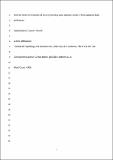Files in this item
How the harsh environment of an army training camp changes human (Homo sapiens) facial preferences
Item metadata
| dc.contributor.author | Batres, Carlota | |
| dc.contributor.author | Perrett, David I. | |
| dc.date.accessioned | 2017-11-17T00:32:24Z | |
| dc.date.available | 2017-11-17T00:32:24Z | |
| dc.date.issued | 2017-01 | |
| dc.identifier | 246730540 | |
| dc.identifier | 828fbae6-98f3-4cd3-ae62-c31aad1346e7 | |
| dc.identifier | 85002546405 | |
| dc.identifier | 000390697900005 | |
| dc.identifier.citation | Batres , C & Perrett , D I 2017 , ' How the harsh environment of an army training camp changes human ( Homo sapiens ) facial preferences ' , Ethology , vol. 123 , no. 1 , pp. 61-68 . https://doi.org/10.1111/eth.12571 | en |
| dc.identifier.issn | 0179-1613 | |
| dc.identifier.other | ORCID: /0000-0002-6025-0939/work/64360923 | |
| dc.identifier.uri | https://hdl.handle.net/10023/12122 | |
| dc.description.abstract | Previous studies suggest that facial preferences may be contingent on an individual’s environment, yet no study has traced how the preferences of the same individuals change as their environment changes. We therefore sought to determine if, and to what extent, adiposity and masculinity preferences are malleable by repeatedly testing students whose environment was not changing as well students undergoing intensive training at an army camp. Our results showed that at baseline, the students at the training camp preferred more feminine male faces. This suggests that even before the training commenced, participants in the training camp may have been in a psychological state that predisposed them to prefer more trustworthy (i.e., more feminine) men. Additionally, we found that the students at the training camp reported increases in multiple stressors as well as showed changes in adiposity preferences. More specifically, we found that increases in the harshness of the environment led to an increased male attraction to cues of higher weight in female faces. Such changes in preferences may be adaptive because they allow men more opportunities to mate with women who are better equipped to survive and reproduce. These findings thus provide new evidence for the malleability of preferences depending on the environment. | |
| dc.format.extent | 8 | |
| dc.format.extent | 514491 | |
| dc.language.iso | eng | |
| dc.relation.ispartof | Ethology | en |
| dc.subject | Adiposity | en |
| dc.subject | Masculinity | en |
| dc.subject | Faces | en |
| dc.subject | Preferences | en |
| dc.subject | Environment | en |
| dc.subject | BF Psychology | en |
| dc.subject | 3rd-DAS | en |
| dc.subject.lcc | BF | en |
| dc.title | How the harsh environment of an army training camp changes human (Homo sapiens) facial preferences | en |
| dc.type | Journal article | en |
| dc.contributor.institution | University of St Andrews. School of Psychology and Neuroscience | en |
| dc.contributor.institution | University of St Andrews. Institute of Behavioural and Neural Sciences | en |
| dc.contributor.institution | University of St Andrews. Centre for Social Learning & Cognitive Evolution | en |
| dc.identifier.doi | 10.1111/eth.12571 | |
| dc.description.status | Peer reviewed | en |
| dc.date.embargoedUntil | 2017-11-16 |
This item appears in the following Collection(s)
Items in the St Andrews Research Repository are protected by copyright, with all rights reserved, unless otherwise indicated.

